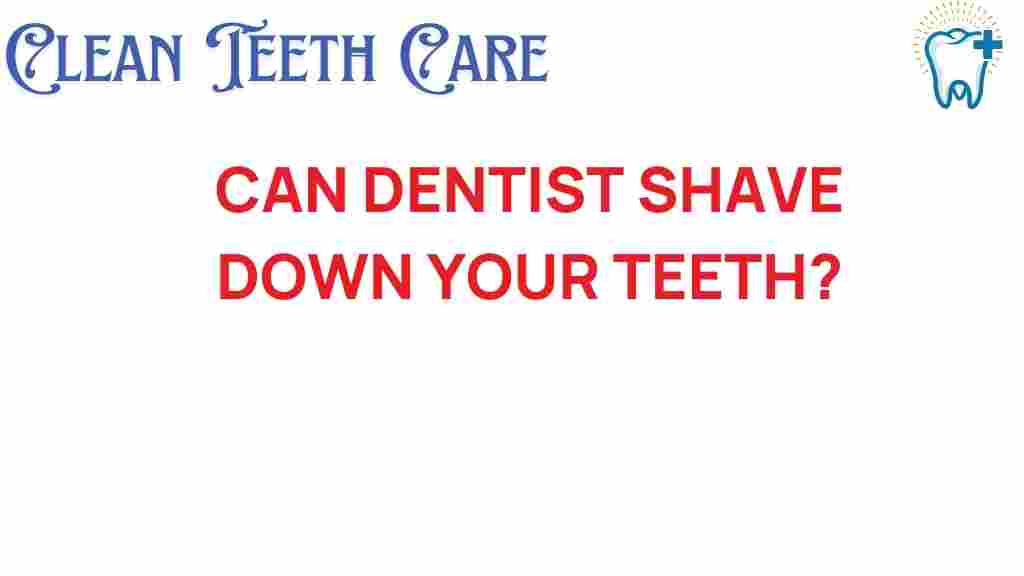Can Dentists Safely Shave Down Your Teeth? Exploring the Pros and Cons
When it comes to achieving that perfect smile, many people consider various dental procedures, including teeth shaving. This practice, often associated with cosmetic dentistry, raises important questions about patient safety and oral health. In this article, we will explore the ins and outs of teeth shaving, its benefits and drawbacks, and what you should know before undergoing this dental care procedure.
Understanding Teeth Shaving
Teeth shaving, also known as tooth contouring or enameloplasty, involves the removal of small amounts of enamel from the surface of the teeth. Dentists perform this procedure to improve the appearance of teeth, correct minor imperfections, and enhance overall aesthetics. It is important to understand that while teeth shaving can be beneficial, it also comes with certain risks and considerations.
The Process of Teeth Shaving
Here’s a step-by-step overview of how the teeth shaving process typically works:
- Consultation: The first step involves scheduling a consultation with a qualified dentist. During this appointment, your dentist will evaluate your teeth and discuss your cosmetic goals.
- Diagnosis: After examining your oral health, your dentist will determine if you are a suitable candidate for teeth shaving. Factors such as the thickness of your enamel and the condition of your teeth will be assessed.
- Preparation: If you are deemed a suitable candidate, the dentist will prepare the area by cleaning your teeth and applying any necessary numbing agents.
- Shaving Process: Using specialized dental tools, the dentist will carefully shave down the enamel of the teeth to achieve the desired shape and size. This process typically takes about 30 minutes to an hour.
- Aftercare: Following the procedure, your dentist will provide guidance on how to care for your teeth to maintain their health and appearance.
Pros of Teeth Shaving
Teeth shaving can offer several advantages, particularly in the realm of cosmetic dentistry:
- Improved Aesthetics: Shaving down teeth can correct minor imperfections like chips, uneven edges, and slight misalignments, leading to a more symmetrical smile.
- Minimally Invasive: Compared to other cosmetic procedures, such as veneers or crowns, teeth shaving is less invasive and often requires minimal downtime.
- Quick Results: The procedure is relatively quick, and patients can often see immediate results without extensive recovery time.
- Enhanced Confidence: A more attractive smile can boost self-esteem and confidence in social and professional settings.
Cons of Teeth Shaving
Despite its benefits, teeth shaving is not without risks. Here are some potential downsides to consider:
- Enamel Removal: The most significant concern with teeth shaving is the removal of enamel, which cannot be replaced. This can lead to increased sensitivity and potential long-term oral health issues.
- Over-Shaving Risks: If not performed carefully, there is a risk of over-shaving, which can compromise the structural integrity of the teeth.
- Temporary Discomfort: Patients may experience some discomfort or sensitivity after the procedure, although this usually subsides within a few days.
- Not Suitable for Everyone: Not all patients are good candidates for teeth shaving. Individuals with thin enamel or existing dental issues may need to consider alternative options.
Patient Safety and Teeth Shaving
Ensuring patient safety during dental procedures is paramount. Here are some key points to consider regarding patient safety and teeth shaving:
- Choose a Qualified Dentist: Always select a licensed and experienced dentist for any dental care procedures. Check their credentials and reviews to ensure they have a good track record.
- Discuss Concerns: Be open with your dentist about any concerns you have regarding enamel removal or sensitivity. A good dentist will address your worries and provide transparent information.
- Follow Aftercare Instructions: Proper aftercare is crucial to minimize complications. Follow your dentist’s advice on oral hygiene and care post-procedure.
- Regular Check-Ups: Schedule regular dental check-ups to monitor your oral health and address any issues that may arise after teeth shaving.
Alternative Options to Teeth Shaving
If you’re concerned about the risks associated with teeth shaving, there are alternative cosmetic dentistry options available:
- Veneers: Thin shells of porcelain or composite resin that cover the front surface of the teeth to improve aesthetics without significant enamel removal.
- Bonding: A composite resin applied to the teeth to correct imperfections, which can be reshaped and polished to match the natural tooth color.
- Braces or Orthodontics: For more severe misalignments, orthodontic treatment can reposition teeth without altering enamel.
Troubleshooting Tips
In case you experience any issues following teeth shaving, here are some troubleshooting tips:
- Sensitivity: If you notice increased sensitivity to hot or cold, use toothpaste designed for sensitive teeth and consult your dentist.
- Discomfort: Over-the-counter pain relievers can help manage discomfort in the days following the procedure.
- Follow-Up Appointment: Schedule a follow-up visit if you have concerns about the results or any discomfort that persists beyond a few days.
Conclusion
Teeth shaving can be a viable option for individuals seeking to enhance their smile through cosmetic dentistry. However, it is essential to weigh the pros and cons carefully, particularly concerning enamel removal and patient safety. By choosing a qualified dentist and discussing all your concerns, you can make an informed decision that prioritizes your oral health. Remember, maintaining good dental care practices and regular check-ups will ensure that your smile remains healthy and beautiful for years to come.
If you’re interested in learning more about cosmetic dentistry options available to you, feel free to contact us for a consultation. For more information on dental health and procedures, you can also visit the American Dental Association website.
This article is in the category Treatments and created by CleanTeethCare Team
